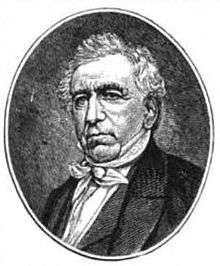Cornelius Lawrence
| Cornelius Lawrence | |
|---|---|
 From Volume 3 of 1896's History of the City of New York: Its Origin, Rise and Progress | |
| Collector of the Port of New York | |
|
In office 1845–1849 | |
| Preceded by | Cornelius P. Van Ness |
| Succeeded by | Hugh Maxwell |
| 61st Mayor of New York City | |
|
In office 1834–1837 | |
| Preceded by | Gideon Lee |
| Succeeded by | Aaron Clark |
| Member of the U.S. House of Representatives from New York's 3rd district | |
|
In office March 4, 1833 – May 14, 1834 | |
| Preceded by | Seat added |
| Succeeded by | Charles G. Ferris |
| Personal details | |
| Born |
February 28, 1791 Flushing, New York |
| Died |
February 20, 1861 (aged 69) Flushing, New York |
| Resting place | Lawrence Cemetery, Bayside, New York |
| Political party |
Democratic-Republican Jacksonian Democratic |
| Spouse(s) | Lydia A. Lawrence |
| Profession |
Merchant Businessman |
Cornelius Van Wyck Lawrence (February 28, 1791 – February 20, 1861) was a politician from New York. He became the first popularly elected Mayor of New York City after the law was changed in 1834.[1]
Early life
Lawrence was born in Flushing, New York, on February 28, 1791. He was a cousin of Effingham Lawrence[2] and was a descendant of John Lawrence and John Bowne, both Quakers and pioneer English settlers of Queens, NY.
Lawrence attended the public schools and worked on his father's farm. He moved to New York City in 1812 to embark on a business career, first at the Shotwell, Hicks & Co. auctioneering firm, and later as a partner in the wholesale dry goods firm of Hicks, Lawrence & Co.
Career
Lawrence was elected as a Jacksonian to the Twenty-third Congress, serving from March 4, 1833, to May 14, 1834, when he resigned, becoming mayor of New York (1834–1837). He also served as director in several banks and trust companies and, was president of the Bank of the State of New York for more than 20 years. From 1845 to 1849, Lawrence served as Collector of the Port of New York.
Personal life
He had a son, James Ogden Lawrence (died August 1, 1904).[3]
Lawrence died in Flushing on February 20, 1861. He was interred in the family burying ground in Bayside, New York.[4]
References
- ↑ "Mayor: Stick With Me, The Best Is Yet To Be". The New York Times. December 30, 1997. Retrieved 2011-05-12.
The change, which would require revising the City Charter, passing legislation in Albany or both, would radically transform a political system that dates to 1834, when Mayor Cornelius Lawrence, a Democrat, became the first candidate of a political party elected by New Yorkers.
- ↑ Andrew R. Dodge, Betty K. Koed, Biographical Directory of the United States Congress, 1774-2005, 2005, page 1425
- ↑ New York Times, James O. Lawrence Dead, August 5, 1904
- ↑ The Lawrence Cemetery, Home page Archived May 26, 2007, at the Wayback Machine., accessed August 15, 2012
External links
- United States Congress. "Cornelius Lawrence (id: L000131)". Biographical Directory of the United States Congress.
- Cornelius Lawrence at Find a Grave
- Cornelius Van Wyck Lawrence at The Political Graveyard
| U.S. House of Representatives | ||
|---|---|---|
| Preceded by Churchill C. Cambreleng Campbell P. White Gulian C. Verplanck |
Member of the U.S. House of Representatives from New York's 3rd congressional district 1833–1834 with Churchill C. Cambreleng, Campbell P. White, and Dudley Selden |
Succeeded by Churchill C. Cambreleng Campbell P. White John J. Morgan Charles G. Ferris |
| Government offices | ||
| Preceded by Cornelius P. Van Ness |
Collector of the Port of New York 1845–1849 |
Succeeded by Hugh Maxwell |